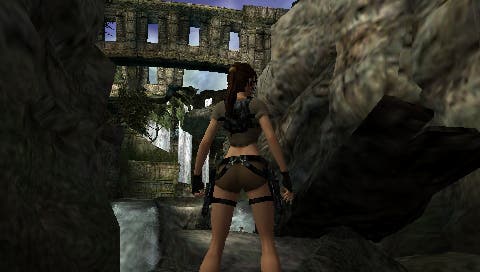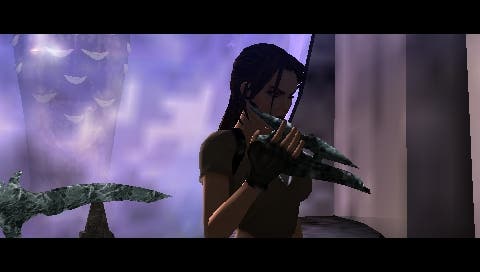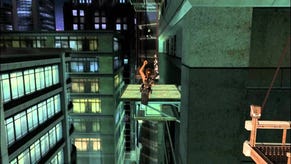Tomb Raider: Legend
You still would.
Folk might've done a lot of standing around at E3, but the queues were nothing next to the ranks of hacks lining the internet earlier this year waiting to have a pop at Tomb Raider. Who could forget Angel of Darkness, after all?
Well, as it turned out, we all could - because it might not have lasted that long, but Tomb Raider: Legend still did more than enough to erase the doubts shadowing Lara during her years off. Crystal Dynamics, best known for the likes of Legacy of Kain and Snowblind (and brilliantly rubbish weasel-and-rabbit platform game Whiplash), didn't just make a better sequel; they gave the series a new starting point.
Criticised in some quarters for an over-reliance on pointing the way - with clearly marked grapple-points, telegraphed jumps, simple puzzles and tap-along action sequences - the reality was that it harnessed these things to escape the traditional grid-layout 3D platform template with so much aplomb that we barely noticed the change. The Lara of Legend could move through environments with greater fluency than anyone since Ubisoft's latter-day Prince of Persia, allowing the player to pick paths that, while quite often obvious, were seldom less than entertaining.
It also served as a timely reminder that Lara is more than just a token woman in games, with some infectiously excitable, ladylike intonation from Zoe off Spooks [Keeley Hawes - Ed], and a story that kept you interested and wrapped itself up with another thing the genre's lacked since The Sands of Time: neatness. Certain elements fell short - the motorbike sections were particularly dismal - but it'll be remembered for the things it got right, and there were plenty of them. Like the rhythmic tapping of triangle to speed up climbing - a trifling detail, but something we'd happily see borrowed elsewhere.
So then to the PSP version, which arrives a bit late but not unwelcome - and on a Sony platform that's been maligned almost as much as the Angel of Darkness in recent months. Can Lara save the day?

Tomb Raider: Legend begins atop a cliff in Bolivia, with Lara jumping over small gaps, moving hand over hand across ledges, swinging from ropes and even yanking things around with a grapple hook. After a bit of scene-setting to bed the controls in, and an early taste of the forgettable lock-on gunplay, Lara gets down to what she's best at: navigating perilous tombs, running along platforms, jumping to ledges to spring to ropes, swinging from trapezes and elegantly landing on the lip of the exit - perhaps having to tap triangle to steady herself if she catches it one-handed. Along the way she moves boxes or hangs from bars to activate switches, occasionally demanding a bit of lateral thinking. It's all very streamlined and not unwelcomely linear, and the constant plotting with her sidekicks over the radio helps ferry the relevance alongside her - with none of that clearing-her-name rubbish this time but all fun stuff about swords, betrayal and Arthurian legends. Plus you get to shoot animals.
The good news is that the PSP version doesn't shirk its responsibility to the material, retaining all the console version's levels - including the surprisingly excellent Croft Manor with its feast of manoeuvrable ledges and poles - and even introducing a few other bits, where you race another player to find the same artefact, or try and get to the end of a tomb sequence within a time-limit. These things aren't just new to the PSP; they're new to Legend as a whole, and that's nothing to scoff at.
The bad news is that the PSP port also has some other things new to Legend: laggy controls, a fiddly camera, and frame-rate issues.

The camera was always going to be hard to implement. Here you have to hold the square button, also used for picking up objects and pushing things around, and use the same analog nub you use for movement to twist the camera. Counter-intuitive to start with, the camera's sluggish response merely adds insult to injury - injury caused by spikes and 100-foot drops.
Fortunately there's a centre-camera button, so your inability to adjust the camera with a second analog stick doesn't entirely rob the game of its fluency. There will be times you're left racing around unable to see where you're going, but in truth the lag on the controls and analog nub, simultaneously imprecise and over-responsive, is the real issue. It'll send you flying off ledges at angles you didn't anticipate, or you'll stumble off them before the game's even registered that you've pressed the jump button. The control lag grates even more during the ill-advised motorbike sections, which were tediously repetitive to begin with and now have rubbish controls to count against them as well. As if to twist the knife, half the time the game doesn't register that you're the hammering square button to move into a push position.
Ironically the control set-up feels more like the very first Tomb Raider's, the lag demanding a deliberate approach pocked with frustration. You might go from there to pointing out that graphically it has more in common with that game too, but while the PSP Legend is blocky and old-fashioned in places, and the textures sometimes muddy, it's not all that bad. Lara's still deliciously detailed when it counts - with the dinner dress in particular a lightning rod for processor cycles - and while it's not as slick as the console versions it still manages to look better than 90 per cent of the other PSP action games.

It's a pity the controls foul things up because in many other respects Legend PSP deserves credit, actually offering more content than any of its console counterparts, with the Croft Manor and full single-player game intact and new game modes including wireless ones. These are quite interesting - about putting your patterns of platform moves together quickly and instinctively - and only rendered frustrating by the technical problems, with the against-the-clock levels in particular becoming a kind of drunken choreography, dancing uncomfortably through corridors and across platforms until you remember the quirks enough in advance to beat the time limit. And the lack of a "Restart" pause menu option makes no sense - if time overruns, you either have to finish the task and hit restart, or quit out and reload your savefile.
All that said, for the most part Legend's problems are largely those of the system itself. Coming at it off the back of the Xbox 360 version the differences inevitably grate, but by the time you reach Ghana - one of the standouts - you've grown to accept them. The PSP version may not have the zip of the others, and you certainly wouldn't choose it over and above them, but Tomb Raider: Legend is a good game, and if you can put up with the initial awkwardness you'll find it was worth the wait. As we said a couple of months ago, Lara's swinging in the right direction, and if the dev-team can keep a handle on it next time out we'll be first in line to congratulate them.
Tomb Raider: Legend is out now on PS2, Xbox, Xbox 360, PC and PSP. You can buy it in shops.










